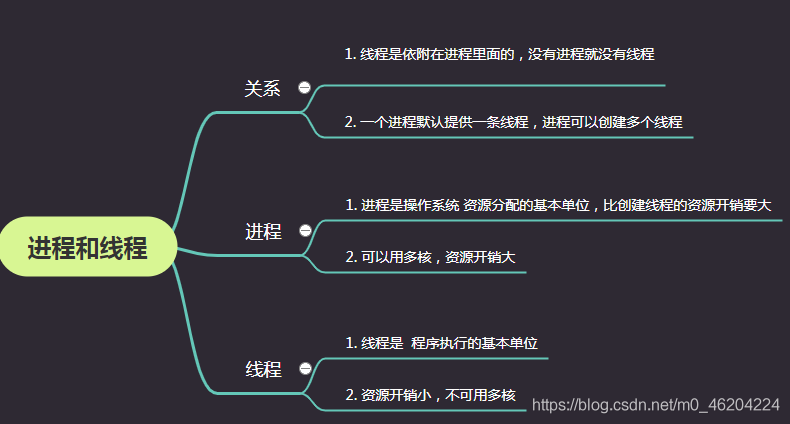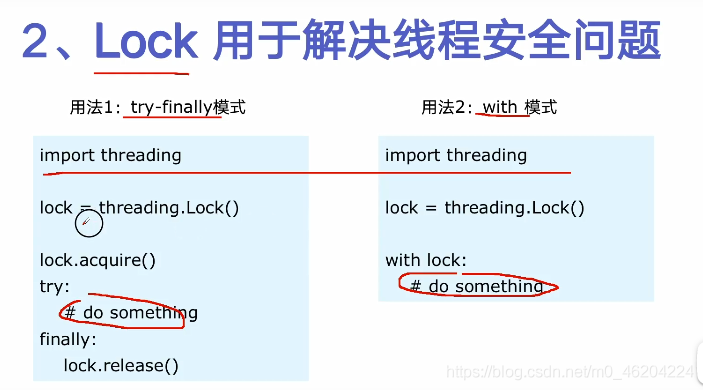說明
相應的學習視頻見鏈接,本文只對重點進行總結。


多進程
重點(只要看下面代碼的main函數即可)
1.創建
2.如何開守護進程
3.多進程,開銷大,用for循環調用多個進程時,后臺cpu一下就上去了
|
1
2
3
4
5
6
7
8
9
10
11
12
13
14
15
16
17
18
19
20
21
22
23
24
25
26
27
28
29
30
31
32
33
34
35
36
|
import timeimport multiprocessingimport osdef dance(who,num): print("dance父進程:{}".format(os.getppid())) for i in range(1,num+1): print("進行編號:{}————{}跳舞。。。{}".format(os.getpid(),who,i)) time.sleep(0.5)def sing(num): print("sing父進程:{}".format(os.getppid())) for i in range(1,num+1): print("進行編號:{}----唱歌。。。{}".format(os.getpid(),i)) time.sleep(0.5)def work(): for i in range(10): print("工作中。。。") time.sleep(0.2)if __name__ == '__main__': # print("main主進程{}".format(os.getpid())) start= time.time() #1 進程的創建與啟動 # # 1.1創建進程對象,注意dance不能加括號 # # dance_process = multiprocessing.process(target=dance)#1.無參數 # dance_process=multiprocessing.process(target=dance,args=("lin",3))#2.以args=元祖方式 # sing_process = multiprocessing.process(target=sing,kwargs={"num":3})#3.以kwargs={}字典方式 # # 1.2啟動進程 # dance_process.start() # sing_process.start() #2.默認-主進程和子進程是分開的,主進程只要1s就可以完成,子進程要2s,主進程會等所有子進程執行完,再退出 # 2.1子守護主進程,當主一但完成,子就斷開(如qq一關閉,所有聊天窗口就沒了).daemon=true work_process = multiprocessing.process(target=work,daemon=true) work_process.start() time.sleep(1) print("主進程完成了!")#主進程和子進程是分開的,主進程只要1s就可以完成,子進程要2s,主進程會等所有子進程執行完,再退出 print("main主進程花費時長:",time.time()-start) # |
多線程

重點
1.創建
2.守護線程
3.線程安全問題(多人搶票,會搶到同一張)
|
1
2
3
4
5
6
7
8
9
10
11
12
13
14
15
16
17
18
19
20
21
22
23
24
25
26
27
28
29
|
import timeimport osimport threadingdef dance(num): for i in range(num): print("進程編號:{},線程編號:{}————跳舞。。。".format(os.getpid(),threading.current_thread())) time.sleep(1)def sing(count): for i in range(count): print("進程編號:{},線程編號:{}----唱歌。。。".format(os.getpid(),threading.current_thread())) time.sleep(1)def task(): time.sleep(1) thread=threading.current_thread() print(thread)if __name__ == '__main__': # start=time.time() # # sing_thread =threading.thread(target=dance,args=(3,),daemon=true)#設置成守護主線程 # sing_thread = threading.thread(target=dance, args=(3,)) # dance_thread = threading.thread(target=sing,kwargs={"count":3}) # # sing_thread.start() # dance_thread.start() # # time.sleep(1) # print("進程編號:{}主線程結束...用時{}".format(os.getpid(),(time.time()-start))) for i in range(10):#多線程之間執行是無序的,由cpu調度 sub_thread = threading.thread(target=task) sub_thread.start() |
線程安全
由于線程直接是無序進行的,且他們共享同一個進程的全部資源,所以會產生線程安全問題(比如多人在線搶票,買到同一張)


#下面代碼在沒有lock鎖時,會賣出0票,加上lock就正常
|
1
2
3
4
5
6
7
8
9
10
11
12
13
14
15
16
17
18
19
20
21
|
import threadingimport timelock =threading.lock()class sum_tickets: def __init__(self,tickets): self.tickets=ticketsdef window(sum_tickets): while true: with lock: if sum_tickets.tickets>0: time.sleep(0.2) print(threading.current_thread().name,"取票{}".format(sum_tickets.tickets)) sum_tickets.tickets-=1 else: breakif __name__ == '__main__': sum_tickets=sum_tickets(10) sub_thread1 = threading.thread(name="窗口1",target=window,args=(sum_tickets,)) sub_thread2 = threading.thread(name="窗口2",target=window,args=(sum_tickets,)) sub_thread1.start() sub_thread2.start() |
高并發拷貝(多進程,多線程)
|
1
2
3
4
5
6
7
8
9
10
11
12
13
14
15
16
17
18
19
20
21
22
23
24
25
26
27
28
29
30
31
32
33
34
35
36
37
38
39
40
41
42
43
44
45
46
47
48
49
50
51
52
53
54
55
56
57
|
import osimport multiprocessingimport threadingimport timedef copy_file(file_name,source_dir,dest_dir): source_path = source_dir+"/"+file_name dest_path =dest_dir+"/"+file_name print("當前進程為:{}".format(os.getpid())) with open(source_path,"rb") as source_file: with open(dest_path,"wb") as dest_file: while true: data=source_file.read(1024) if data: dest_file.write(data) else: break passif __name__ == '__main__': source_dir=r'c:\users\administrator\desktop\注意力' dest_dir=r'c:\users\administrator\desktop\test' start = time.time() try: os.mkdir(dest_dir) except: print("目標文件已存在") file_list =os.listdir(source_dir) count=0 #1多進程 for file_name in file_list: count+=1 print(count) sub_processor=multiprocessing.process(target=copy_file, args=(file_name,source_dir,dest_dir)) sub_processor.start() # time.sleep(20) print(time.time()-start)#這里有主進程和子進程,通過打印可以看出,主進程在創建1,2,3,4,,,21過程中,子進程已有的開始執行,也就是說,每個進程是互不影響的# 9# 10# 11# 12# 13# 當前進程為:2936(當主進程創建第13個時,此時,第一個子進程開始工作)# 14# 當前進程為:10120# 當前進程為:10440# 15# 當前進程為:9508 # 2多線程 # for file_name in file_list: # count += 1 # print(count) # sub_thread = threading.thread(target=copy_file, # args=(file_name, source_dir, dest_dir)) # sub_thread.start() # # time.sleep(20) # print(time.time() - start) |
總結
本篇文章就到這里了,希望能給你帶來幫助,也希望您能夠多多關注服務器之家的更多內容!
原文鏈接:https://blog.csdn.net/m0_46204224/article/details/119737937










